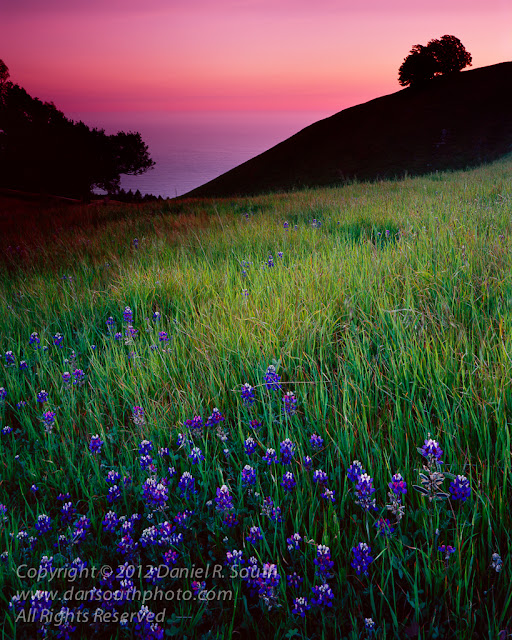The possibilities of digital photography began to catch my interest in the late 1990s. Unfortunately, digital imaging technology was still in its infancy. I continued to shoot film while waiting for the quality of digital cameras to improve.
There's a certain mystery to film. Waiting days or weeks to see the results of an exposure can be frustrating. You can't take a peek at the LCD screen and recompose or make other adjustments. You need to evaluate each scene carefully and commit to your most skillful prediction. No matter how much experience you have with film, there are always surprises.
The surprises may be pleasant, even exhilarating; sometimes not so much. I've thrown entire rolls of film into the trash bin over the years. I've also been seen jumping for joy beside a light table upon receipt of newly developed chromes. Unpredictability is part of the adventure.
 |
| Lupines At Sunset, California Coast |
Color reversal film, commonly known as slide film, is amazing for documenting colors. These films are sensitive to slight color casts that our internal optical processing system filters out.
Our brain filters colors possibly in an attempt to protect us from recognizable threats. If a berry with a certain shade of red will make us sick, we don't want that berry to look differently on a sunny day than it does on a cloudy day, or at sunset versus high noon. Unfortunately, this built-in safety mechanism reduces our ability to see colors accurately and objectively.
Film doesn't filter colors automatically, nor does it engage the automatic white balance functionality of a digital camera. Film records any color that was present at the time of exposure including colors that humans can't see. But here is the interesting part - when we look at a finished slide or print of the scene, we do see those missing colors and we see them accurately.
I have yet to discover a good explanation for this paradox in color perception. How is it that colors once invisible to use become visible once they have been recorded by photographic processes? This is yet another reason why cameras tend to yield surprising results.
Photography helps us to see and to understand our world more clearly by showing us what we were unable to see in the moment.
Camera: Ebony SV45TE
Lens: Schneider 110mm f/5.6 Super-Symmar XL
Film: Fujichrome Velvia 100
Wishing you great light and meaningful moments!
Copyright 2012 Daniel R. South
www.dansouthphoto.com
All Rights Reserved